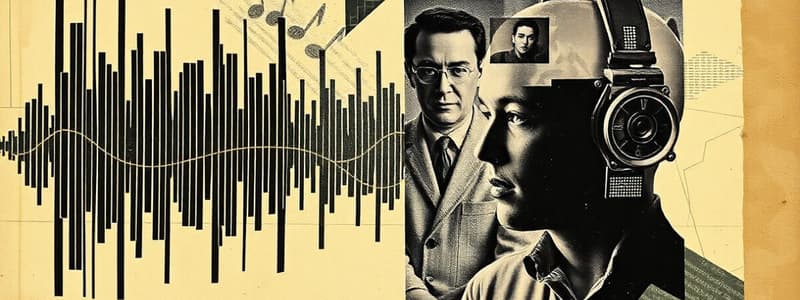Podcast
Questions and Answers
What does the Q in equalisation refer to?
What does the Q in equalisation refer to?
- The total volume level
- The type of audio file used
- The bandwidth control of frequencies (correct)
- The length of the audio track
In compression, what does a ratio of 4:1 signify?
In compression, what does a ratio of 4:1 signify?
- For every 4dB below the threshold, 1dB is output
- For every 4dB above the threshold, 1dB is output (correct)
- For every 4dB above the threshold, 2dB is output
- For every 4dB below the threshold, no compression occurs
What is the purpose of using equalisation in audio production?
What is the purpose of using equalisation in audio production?
- To amplify the entire track equally
- To control the loudness of specific frequencies (correct)
- To modify overall volume levels only
- To extend the length of audio clips
What is meant by 'Attack Time' in a compression context?
What is meant by 'Attack Time' in a compression context?
Which definition best describes 'Hard Knee' in compression?
Which definition best describes 'Hard Knee' in compression?
What is the theoretical range of human hearing in Hertz?
What is the theoretical range of human hearing in Hertz?
Which sample rate is typically used for CD quality audio?
Which sample rate is typically used for CD quality audio?
What is the dynamic range of a 16-bit recording in decibels?
What is the dynamic range of a 16-bit recording in decibels?
At what dB level does the threshold of pain occur?
At what dB level does the threshold of pain occur?
What is typically the range of sounds that telephones can effectively transmit?
What is typically the range of sounds that telephones can effectively transmit?
Which term refers to the loudness level being recorded or the input signal level?
Which term refers to the loudness level being recorded or the input signal level?
What is the typical target recording level when tracking audio?
What is the typical target recording level when tracking audio?
What does '0 dB' indicate in the context of gain staging?
What does '0 dB' indicate in the context of gain staging?
Flashcards
Dynamic Range
Dynamic Range
The range between the loudest and softest parts of a sound, measured in decibels (dB).
Compression
Compression
A technique that reduces the dynamic range of audio by limiting the difference between loud and soft sounds.
Threshold
Threshold
The level at which the compressor starts reducing the dynamic range.
Ratio
Ratio
Signup and view all the flashcards
Graphic Equalizer
Graphic Equalizer
Signup and view all the flashcards
Frequency (Hz)
Frequency (Hz)
Signup and view all the flashcards
Threshold of Pain
Threshold of Pain
Signup and view all the flashcards
Gain Staging
Gain Staging
Signup and view all the flashcards
Tracking
Tracking
Signup and view all the flashcards
Gain
Gain
Signup and view all the flashcards
Level
Level
Signup and view all the flashcards
Mixing
Mixing
Signup and view all the flashcards
Study Notes
Audio Aspects of Communication
- Frequency: Measured in Hertz (Hz), representing cycles per second.
- Higher frequency corresponds to a higher pitch.
- Human Hearing Range: 20Hz to 20,000Hz (20kHz).
- Sample Rate: Example CD quality: 44.1 kHz (44,100 Hz).
- Frequency Range and Descriptions:
- Infrasonic: Frequencies below 20Hz
- Sonic: Frequencies between 20Hz and 20kHz
- Ultrasonic: Frequencies between 20kHz and 1 GHz
- Hypersonic: Frequencies above 1 GHz
- Hearing Capability (Just for Fun):
- Humans: 20 Hz to 20,000 Hz
- Dogs: 50 Hz to 45,000 Hz
- Cats: 45 Hz to 85,000 Hz
- Elephants: 1 Hz to 200,000 Hz
- Sound Frequency Examples:
- Vowel Sounds (like short "O"): 250-1000 Hz
- Consonant Sounds (like "S"): 1500-6000 Hz
- Important Sounds: 250 - 6000 Hz
- Normal Hearing: 20-20,000 Hz
- Human Voice Range: Approximately 80 Hz to 4000 Hz, with fundamentals ranging lower (males 80-180Hz, females 165-255Hz).
- Telephone Sample Rate: Typically 8000 Hz, with a range from 300 Hz to 3400 Hz. Sample rate is usually double (or more) the range of sounds being recorded
- Decibels (dB): Measuring sound wave amplitude, where higher amplitude means louder volume. Dynamic range expressed in decibels.
- 0 dB: Threshold of human hearing (sounds below this cannot be heard)
- 16-Bit Recording: Dynamic range of 96 dB
- 24-Bit Recording: Dynamic range of 144 dB
- Dynamic Range: The difference between the lowest and highest sounds in a recording
- 120-140 dB: Threshold of pain, highest theoretical range of Human Hearing (in terms of Dynamic Range)
- Gain Staging is used for recording.
- 0 dB = Unity Gain.
- Mixing our tracks
- Volume Fader
Types of Audio Input/Output Devices
- Microphone Polar Patterns: Omnidirectional, Bi-directional (Figure of 8), Subcardioid, Cardioid, Hypercardioid, Supercardioid, Shotgun
Audio Processing
-
Equalization (EQ):
-
Parametric EQ: Allows user control of center frequency, bandwidth (Q), and gain.
-
Graphic EQ: User controls the gain for each frequency band.
-
Freq = Frequency in Hz; Gain = Boost + or Cut - in dB; Q = Bandwidth (Higher Q = more precise control, Lower Q = broader control).
-
Compression:
-
Dynamic Range Control.
-
Reducing the difference between loudest and softest sounds in audio.
-
Ratio (e.g., 1:1, 2:1, 4:1, 8:1): How much compression.
-
Threshold: When compressor starts working.
-
Knee: How gradually the compressor engages (Hard Knee vs. Soft Knee).
-
Attack Time: How quickly signal starts being compressed.
-
Release Time: How quickly signal stops being compressed.
Other Related Audio Terms
- DAW: Digital Audio Workstation
- MIDI: Musical Instrument Digital Interface
- AD/DA (Converters): Analog-to-Digital / Digital-to-Analog
Recommended Audio Channels
- A list of recommended YouTube channels for audio topics, with channel names and brief descriptions (e.g., Pensado's Place, ADSR).
Studying That Suits You
Use AI to generate personalized quizzes and flashcards to suit your learning preferences.




